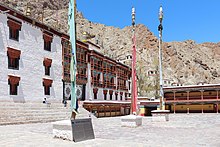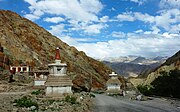| Hemis Monastery | |
|---|---|
 Hemis Monastery Hemis Monastery | |
| Religion | |
| Affiliation | Tibetan Buddhism |
| Sect | Drukpa |
| Leadership | The Twelfth Gyalwang Drukpa |
| Location | |
| Location | Ladakh, India |
| Country | India |
 | |
| Geographic coordinates | 33°54′44.91″N 77°42′10.2″E / 33.9124750°N 77.702833°E / 33.9124750; 77.702833 |
| Architecture | |
| Style | Tibetan Architecture |
| Founder | Sengge Namgyal |


Hemis Monastery is a Himalayan Buddhist monastery (gompa) of the Drukpa Lineage, in Hemis on the bank of the Indus River, Ladakh, India. Situated 45 km from Leh, it was re-established in 1672 by the Ladakhi king Sengge Namgyal. The annual Hemis festival honouring Padmasambhava is held there in early June.
Hemis village is located 40 km southeast of Leh on Leh-Manali Highway and under-construction Bhanupli–Leh line.
History
Hemis Monastery existed before the 11th century.
In 1894 Russian journalist Nicolas Notovitch claimed Hemis as the origin of an otherwise unknown gospel, the Life of Saint Issa, Best of the Sons of Men, in which Jesus is said to have travelled to India during his 'lost years'. According to Notovitch, the work had been preserved in the Hemis library and was shown to him by the monks there while he was recuperating from a broken leg, and his Sherpa guide translated it for him. Notovich's version of the manuscript was translated from Tibetan to Russian to French to English. However, historians view Notovitch as having fabricated the evidence, which he allegedly admitted himself. Bible scholar Bart D. Ehrman states that "Today there is not a single recognized scholar on the planet who has any doubts about the matter. The entire story was invented by Notovitch, who earned a good deal of money and a substantial amount of notoriety for his hoax."
The Indian Pandit Swami Abhedananda claims to have read the same manuscript and published his account of viewing it after his visit to Hemis in 1921. Abhedananda claims on the book jacket that it was translated for him with the help of a "local Lama interpreter", and it substantially matched Notovich's publication. After Abhedananda's death, one of his disciples said that when he went to the monastery to ask about the documents, he was told that they had disappeared.
Paintings of Mahasiddhas

In the courtyard of the monastery, there is a gallery with paintings of the Eighty-Four Mahasiddhas, dating back to the 17th century. These paintings are created using ground mineral pigments.
-
 Paintings of Mahasiddhas 1
Paintings of Mahasiddhas 1
-
 Paintings of Mahasiddhas 2
Paintings of Mahasiddhas 2
-
 Paintings of Mahasiddhas 3
Paintings of Mahasiddhas 3
-
 Paintings of Mahasiddhas 4
Paintings of Mahasiddhas 4
-
 Paintings of Mahasiddhas 5
Paintings of Mahasiddhas 5
-
 Paintings of Mahasiddhas 6
Paintings of Mahasiddhas 6
-
 Paintings of Mahasiddhas 7
Paintings of Mahasiddhas 7
-
 Paintings of Mahasiddhas 8
Paintings of Mahasiddhas 8
-
 Paintings of Mahasiddhas 9
Paintings of Mahasiddhas 9
-
 Paintings of Mahasiddhas 10
Paintings of Mahasiddhas 10
-
 Paintings of Mahasiddhas 11
Paintings of Mahasiddhas 11
-
 Paintings of Mahasiddhas 12
Paintings of Mahasiddhas 12
-
 Paintings of Mahasiddhas 13
Paintings of Mahasiddhas 13
-
 Paintings of Mahasiddhas 14
Paintings of Mahasiddhas 14
Hemis Festival
The Hemis Festival is dedicated to Lord Padmasambhava (Guru Rinpoche), revered as the representative reincarnate of Buddha. He is believed to have been born on the 10th day of the fifth month (non or jyestha) of the Monkey year of the Tibetan calendar, as predicted by the Buddha Shakyamuni. It is also believed that his life mission was, and remains, to improve the spiritual condition of all living beings. Therefore, on this day, which comes once in a cycle of 12 years, Hemis observes a major extravaganza in his memory. The observance of these sacred rituals is believed to provide spiritual strength and good health. The Hemis festival takes place in the rectangular courtyard in front of the main door of the monastery. The space is wide and open, save for two raised square platforms, three feet high with a sacred pole in the center. A raised dais with a richly cushioned seat, a finely painted small Tibetan table, and ceremonial items – cups full of holy water, uncooked rice, and tormas made of dough and butter, along with incense sticks – are placed. A number of musicians play traditional music with four pairs of cymbals, large-pan drums, small trumpets, and large-sized wind instruments. Next to them, a small space is assigned for the lamas to sit.
The ceremonies begin with an early morning ritual atop the gompa, where, to the beat of drums, the resounding clash of cymbals, and the spiritual wail of pipes, the portrait of "Dadmokarpo" or "Rygyalsras Rinpoche" is ceremoniously displayed for all to admire and worship.
The most esoteric festivities include the mystic mask dances. The mask dances of Ladakh are collectively referred to as chams performances. Chams performances are essentially part of the Tantric tradition, performed only in those gompas that follow the Tantric Vajrayana teachings, and the monks perform tantric worship.
Gallery
-
 Chortens at Hemis gompa
Chortens at Hemis gompa
-
 Mani wall along the driveway to Hemis Monastery
Mani wall along the driveway to Hemis Monastery
-
 View from Hemis Monastery. 2010
View from Hemis Monastery. 2010
-
 Hemis Monastery in Ladakh, by Vasily Vereshchagin (1875)
Hemis Monastery in Ladakh, by Vasily Vereshchagin (1875)
-
 The entrance to Hemis monastery
The entrance to Hemis monastery
-
 Inside the Hemis monastery
Inside the Hemis monastery
-
 Mural painting in the Hemis monastery
Mural painting in the Hemis monastery
-
 Traditional monk dance at Hemis Festival
Traditional monk dance at Hemis Festival
-
 Traditional Ladakhi women at Hemis monastery
Traditional Ladakhi women at Hemis monastery
See also
Footnotes
| Part of a series on |
| Tibetan Buddhism |
|---|
 |
| Schools |
Key personalities
|
Teachings
|
| Practices and attainment |
| Major monasteries |
| Institutional roles |
| Festivals |
| Texts |
| Art |
| History and overview |
- Nicolas Notovitch (1907). The Unknown Life Of Jesus Christ, Chicago: Progressive Thinker Pub. House
- "The original scrolls brought from India to Nepal, and from Nepaul to Thibet, relating to the life of Issa, are written in the Pali language and are actually in Lhassa; but a copy in our language—I mean the Thibetan—is in this convent."
- New Testament Apocrypha, Vol. 1: Gospels and Related Writings by Wilhelm Schneemelcher and R. Mcl. Wilson (1 December 1990) ISBN 066422721X page 84 "a particular book by Nicolas Notovich (Di Lucke im Leben Jesus 1894) ... shortly after the publication of the book, the reports of travel experiences were already unmasked as lies. The fantasies about Jesus in India were also soon recognized as invention... down to today, nobody has had a glimpse of the manuscripts with the alleged narratives about Jesus"
- Indology, Indomania, and Orientalism by Douglas T. McGetchin (1 January 2010) Fairleigh Dickinson University Press ISBN 083864208X page 133 "Faced with this cross-examination, Notovich confessed to fabricating his evidence."
- Ehrman, Bart D. (February 2011). "8. Forgeries, Lies, Deceptions, and the Writings of the New Testament. Modern Forgeries, Lies, and Deceptions". Forged: Writing in the Name of God—Why the Bible's Authors Are Not Who We Think They Are (First Edition. EPub ed.). New York: HarperCollins e-books. pp. 282–283. ISBN 978-0-06-207863-6. Archived from the original on 15 February 2012. Retrieved 8 September 2011.
- Swami Abhedananda's "Journey into Kashmir and Tibet" rendered into English by Ansupati Dasgupta and Kunja Bihari Kundu.
- Hooper, Richard (1 May 2012). Jesus, Buddha, Krishna, and Lao Tzu: The Parallel Sayings. Newburyport, Massachusetts: Hampton Roads Publishing. p. 176. ISBN 978-1571746801.
References
- Francke, A. H. (1914, 1926). Antiquities of Indian Tibet. Two Volumes. Calcutta. 1972 reprint: S. Chand, New Delhi.
External links
| Capital: Kargil; Leh | |||||||||||||||||||
| State symbols | |||||||||||||||||||
| History |
| ||||||||||||||||||
| Administration | |||||||||||||||||||
| Geography |
| ||||||||||||||||||
| Human settlements | |||||||||||||||||||
| Culture |
| ||||||||||||||||||
| Tourism and wildlife |
| ||||||||||||||||||
| Transport |
| ||||||||||||||||||
| Infrastructure |
| ||||||||||||||||||
| See also |
| ||||||||||||||||||